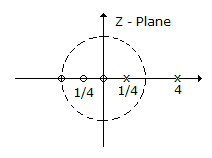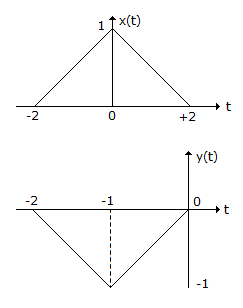Discussion
Home ‣ Electronics and Communication Engineering ‣ Signals and Systems Comments
- Question
If £[f(t)] = F(s), then £[f(t - T)] =
Options- A. est F(s)
- B. e-st F(s)
- C.
![If £[f(t)] = F(s), then £[f(t - T)] = est F(s) e-st F(s) A linear system is one in which the relatio](../../../imagesresources/questions-resources/VgiSLfgapvAYKgIG.png)
- D.
![If £[f(t)] = F(s), then £[f(t - T)] = est F(s) e-st F(s) A linear system is one in which the relatio](../../../imagesresources/questions-resources/vBmaUsVlRuuwitYd.png)
- Correct Answer
- e-st F(s)
ExplanationA linear system is one in which the relationship between input and output is linear.All linear system possess the property of superposition i.e., if input u1 gives output y1 and input u2 gives output y2 then input u1 + u2 will give output y1 + y2.
Superposition implies homogencity i.e., if input u gives output y, then input ku gives output ky where k is a rational number.
In general a system is linear if a transformation T satisfies the relation
T(au1 + ?u2) = aT(u1) + ?T(u2)
where a and ? are constant.
Signals and Systems problems
Search Results
- 1. The system with given pole-zero diagram is

Options- A. casual
- B. non-casual
- C. both sided
- D. not-possible Discuss
Correct Answer: not-possible
Explanation:
Because no.of zero is more than Pole, therefore when you find transfer function.Numerator power will higher than denominator, and such transfer functions is not realizable.
- 2. A voltage wave having 5% fifth harmonic content is applied to a series RC circuit. The percentage fifth harmonic content in the current wave will be
Options- A. 5%
- B. more than 5%
- C. less than 5%
- D. equal or more than 5% Discuss
Correct Answer: more than 5%
Explanation:
IC = V(j?C).- 3. Let x(t) and y(t) with F.T. x(f) and y(f) respectively be related as shown in figure

Then y(f) is
Options- A.

- B.

- C. -X(f/2)ej2pf
- D. -X(f/2)e- j2pf Discuss
Correct Answer:
Explanation:
By applying time shifting and scaling property.- 4. The signal defined by the equations f(t) = 0 for t < 0, f(t) = E for 0 ? t ? a and f(t) = 0 for t > a is
Options- A. a step function
- B. a pulse function
- C. a shifted step function originating at t = a
- D. none of the above Discuss
Correct Answer: a pulse function
Explanation:
It is a pulse lasting for t = a.- 5. If I (s)
 , the final value of i(t) is
, the final value of i(t) is
Options- A. 5A
- B. 12.5 A
- C. 0.05 A
- D. 1250 A Discuss
Correct Answer: 12.5 A
Explanation:

- 6. As per time displacement theorem in Laplace transformation, displacement in the time domain by T becomes
Options- A. division by s in the s domain
- B. division by e-sT in the s domain
- C. multiplication by s in the s domain
- D. multiplication by e-sT in the s domain Discuss
Correct Answer: multiplication by e-sT in the s domain
Explanation:
£f(t - T) = e-st F(s).- 7. An energy signal has G(f) = 10. Its energy density spectrum is
Options- A. 10
- B. 100
- C. 50
- D. 20 Discuss
Correct Answer: 100
Explanation:
Energy density spectrum = |G(f)|2 = |10|2 = 100.- 8. A signal m(t) is multiplied by a sinusoidal waveform of frequency fc such that
v(t)=m(t) cos 2pfct
If Fourier transform of m(t) is M(f), Fourier transform of v(t) will be
Options- A. 0.5 M(f + fc)
- B. 0.5 M(f - fc)
- C. 0.5 M(f + fc) + 0.5 M(f - fc)
- D. 0.5 M(f - fc) + 0.5 M(f - fc) Discuss
Correct Answer: 0.5 M(f + fc) + 0.5 M(f - fc)
Explanation:
It is a modulation process. The resultant has (f + fc) and (f - fc) terms.- 9. The analog signal m(t) is given below m(t) = 4 cos 100 pt + 8 sin 200 pt + cos 300 pt, the Nyquist sampling rate will be
Options- A. 1/100
- B. 1/200
- C. 1/300
- D. 1/600 Discuss
Correct Answer: 1/300
Explanation:
m (t) = 4 cos 100 pt + 8 sin 200 pt + cos 300 ptNyquist sampling freq fs ? 2fm where fm is highest frequency component in given signal and highest fm in 3rd part
2pfmt = 300 pt
fm = 150 Hz
fs = 2 x 150 p 300 Hz
 .
.
- 10. Which one is a linear system?
Options- A. y[n] = x[n] x x[n - 1]
- B. y[n] = x[n] + x[n - 10]
- C. y[n] = x2[n]
- D. (a) and (c) Discuss
Correct Answer: y[n] = x[n] + x[n - 10]
Explanation:
For linearityy1[n] = x1[n] + x2[n - 10] ...(1)
y2 = x2[n] + x2[n - 10] ...(2)
y1[n] = x1[n] + x2[n] + x2[n - 10] + x2[n - 10] ...(3)
Now find y1[n] + y2[n]
Corresponding to x1[n] + x2[n]
It is same as equation (3) hence linear.
But in part (c) y[n] = x2[n]
? y1[n] = x21[n], y2[n] = x22[n]? y1[n] + y2[n] = x22[n]...3
But y1[n] + y2[n]
Corresponing x1[n] + x2[n] is y1[n] + y2[n] = {x1[n] + x2[n]}2
= x12[n] + x22[n] + 2x1[n] x2[n]....4
Equations (3) and (4) are not same hence not linear.
Comments
There are no comments.
More in Electronics and Communication Engineering:
Programming
Copyright ©CuriousTab. All rights reserved.
- 1. The system with given pole-zero diagram is
